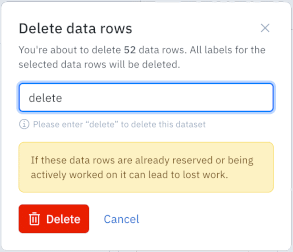| Preview selection | Displays selected data rows in a detailed view. |
| Add batch to project | Groups selected data rows into a batch and then opens the Review batch view, which lets you queue data rows for labeling. |
| send to Annotate | Send data row prediction(s) to a project |
| New Experiment | Send data row selection to a new experiment |
| Send to Experiment | Send data row selection to an existing experiment |
| Add metadata | Opens the Add metadata panel for the selected data rows; this lets you assign metadata values to the selected rows.Metadata values must exist before they can be added to data rows. |
| Add classification | Assigns a classification to the selected data rows.The classification must already exist and be defined by an ontology associated with a project. |
| Export data v2 | Opens the Export panel, which lets you create a JSON file designed to export the selected data rows using the settings defined in the panel. |
| Select all | Selects all data rows currently in view. |
| Deselect all | Clears data row selections. |
| Delete data rows | Deletes selected data rows, after confirmation. For details, see Delete data rows. |

